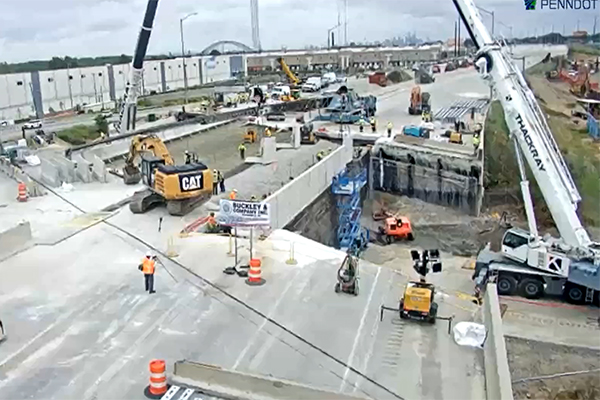 The bridge reopened with six lanes of temporary pavement covering glass aggregate backfill on 23 June, less than two weeks after the elevated section of I-95 in Northeast Philadelphia collapsed on the morning of 11 June after a truck carrying 38,641l of gasoline overturned, slid into a concrete support and burst into flames. The vehicle reportedly lost control and flipped onto its side, killing the driver and compromising the steel and concrete supports holding up the I-95 Bridge near Cottman Avenue. The body of the 53-year-old driver, Nathan Moody, was recovered by rescue crews from the wreckage the day after the accident.
The bridge reopened with six lanes of temporary pavement covering glass aggregate backfill on 23 June, less than two weeks after the elevated section of I-95 in Northeast Philadelphia collapsed on the morning of 11 June after a truck carrying 38,641l of gasoline overturned, slid into a concrete support and burst into flames. The vehicle reportedly lost control and flipped onto its side, killing the driver and compromising the steel and concrete supports holding up the I-95 Bridge near Cottman Avenue. The body of the 53-year-old driver, Nathan Moody, was recovered by rescue crews from the wreckage the day after the accident.

The welded steel bridge had a 31.7m span and a 4.4m clearance, it was constructed in 2016 and rated in good condition, according to state data. It was built as part of a US$300 million project to replace bridges along a stretch of I-95. It saw average daily traffic of about 160,000 vehicles, 8% of which were trucks, according to government data.
It is suggested that the weakening of the steel played the biggest role in the overpass collapse on to the highway below, with the rapid expansion of materials from the heat being a contributing factor.

Contractor C Abbonizio began demolition works to clear out the area on 12 June and finished on 15 June.

Officials estimated replacing the bridge and the adjacent southbound span deemed unsafe for traffic could take months. An emergency declaration made US$7 million in state funding immediately available and allowed the state to proceed without following normal bidding rules. An additional US$3 million in federal money have since been allocated to the project.
A plan to rebuild the damaged elevated highway by filling in the area between the two road sections and paving over was announced at a press conference on 14 June. The Philadelphia-based contractor Buckley & Co was hired by the Pennsylvania Department of Transportation (PennDot) to build both the temporary roadway and the permanent replacement bridge.
About 5,505m3 of recycled glass foam aggregate backfilled the 24m-wide centre portion of the 45.7m-wide highway where the bridge was located. The aggregate for the interim solution was made by Aero Aggregates of North America and according to officials – is lighter than most construction fill and should help keep the temporary bridge from damaging clay pipes underneath the soft soil as it settles. Using recycled glass material speeds up the process four times faster than traditional soil and its placement is not affected by weather conditions according to Archie Filshill, Aero Aggregates CEO.
The temporary road surface allows three lanes of traffic to pass in each direction, but the exits near the destroyed bridge will remain closed longer.
Construction will now begin on the outer lanes, about 10.6m on each side of the middle section. Once the outer lanes are complete, traffic will be redirected to them, the backfill and temporary roadway will be removed, allowing construction of the middle section to be completed and the exits to reopen.
Federal Highway Administration officials have estimated that the permanent replacement would cost US$25-30 million. An update on the timeline for the permanent bridge is awaited now that the temporary fix is done.
Engineers took core samples from the bridge’s concrete abutments and are conducting other tests to see how usable they are, officials said. The northern abutment hit by the truck may require substantial repair and replacement, according to an interview given by Din Abazi, chief bridge engineer for PennDot District 6, to regional news sources.





